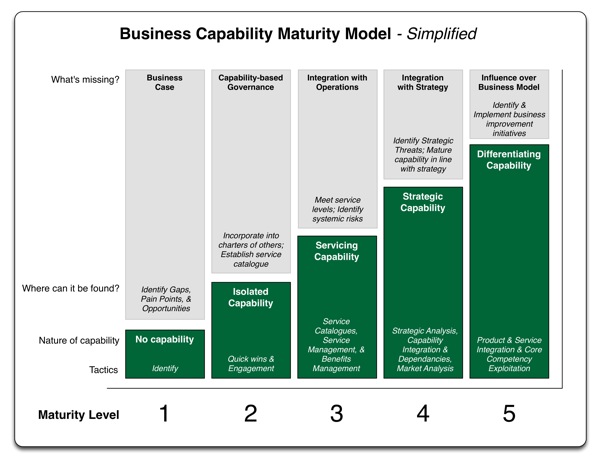With this year the year of capability engineering I spent last night building out a simplified maturity model for how new business capabilities might evolve. This model is a lot of thinking packed into a single artefact, and still a work in progress.
All new business capabilities got through a number of maturity levels before they are a recognised capability of the organisation. Aspirational capabilities identified and sponsored by the executive team also go through the same journey; however, there is in this case greater visibility of the progress through maturity levels to the executive team.

Level 1 – No capability
No formal capability exists. Although competencies may exist in the organisation there is:
1. No explicit decision on the level of standardisation / centralisation required.
2. No formal accountably for the capability within governance structures
3. No agreed understanding of the capability and how it contributes to the operating model at the executive level
4. No explicit references to the capability in strategic planning (or equivalent) processes
5. No understanding of how the capability contributes to the product strategy or to the development and delivery of products / services
Level 2 – Isolated capability
An isolated capability exists. This isolation can appear in any or all of the following dimensions:
1. Isolated application of the capability to solve a single or small number of business problems
2. Recognition of duplication where superficially similar pockets of capability are identified throughout the organisation but they are isolated from one another
3. New or business critical application of the capability is built or identified but considered an exception to one or more policies, standards, or organisational behaviours despite having clear business benefits
Level 3 – Servicing capability
Integration of an isolated capability with the organisation begins with establishing service managed around the capability. This creates dependencies with other business units and makes the capability critical to operations.
The use of service management principles achieves the following:
1. Creates internal “customers” for the capability
2. Allows the operation of the capability to be separated from the services; providing an opportunity to leverage the services of other business units to deliver the capability’s services.
Level 4 – Strategic capability
The executive team explicitly reference the capability during decision-making and the strategic planning (or equivalent) process.
Level 5 – Differentiating capability
The relationship between the capability and how the capability contributes to the product strategy and to the development and delivery of products / services is managed.

